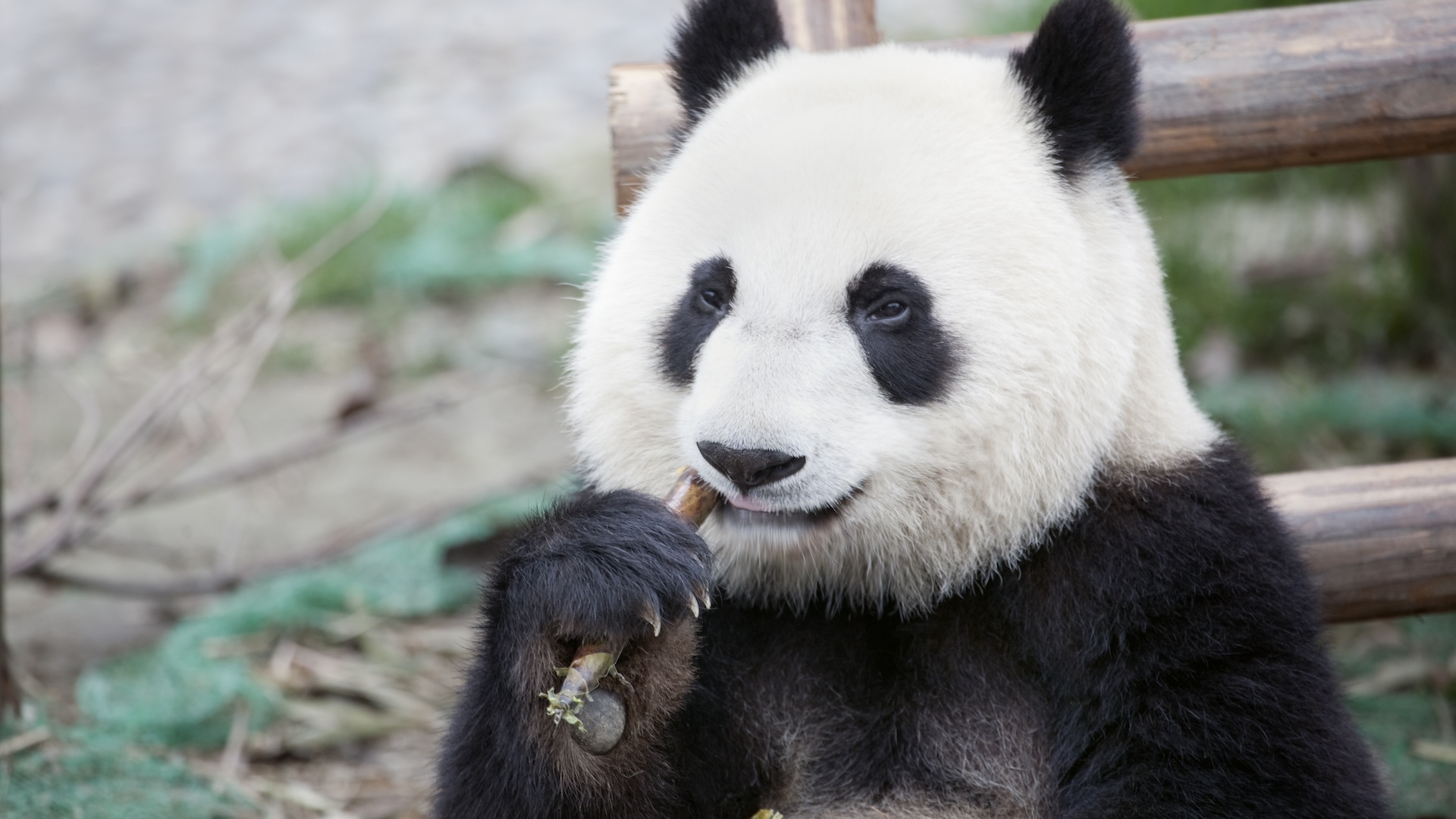
Together with its black-and-white fur, slothful behavior and cuddly demeanor, bamboo is a defining feature of the critically-endangered giant panda (Ailuropoda melanoleuca). A single panda can consume between 26 and 84 pounds (12 to 38 kilograms) of the vegetation each day, and may spend as much as 16 hours daily eating mouthful after mouthful of this fibrous, chewy plant.
These consumption patterns are so intense that Feng Li, a researcher at China West Normal University, describes the panda as a “mobile shredder of bamboo.” But do panda bears ever expand their diets and eat anything besides this fast-growing plant?
Typically, the answer is no — although there are some rare exceptions. “There have been cases where wild giant pandas occasionally eat small animals,” Li told Live Science in an email. Li mentioned rare instances documented in the Qinling Mountain region of China, where giant pandas were found gnawing the bones of a takin (Budorcas taxicolor), a goat-like wild ungulate. They have also been found occasionally preying on Chinese bamboo rats (Rhizomys sinensis).
John Speakman, the chair of zoology at the University of Aberdeen in the United Kingdom, confirms that these cases are opportunistic and unusual: “There is a picture online of [a panda] in a zoo that captured and ate a peacock. But as far as I know these are really chance encounters.”
Aside from these rare lapses into carnivorism, pandas stick exclusively to bamboo. However, there’s an interesting twist to this story, because there’s plenty of evidence to show that pandas actually should have much more diverse diets. In fact, they’re not especially well-suited to eating bamboo.
Research has shown that the bears have a gut architecture that’s similar to carnivores, like their bear cousins, and that their stomachs lack the many-chambered structure that other herbivores use to process copious quantities of plants. What’s more, the microbes that populate their gut flora are more like those of meat-eaters, and are capable of processing and extracting protein. Those microbes are unsuited to breaking down plants. Panda poop reveals this too: researchers on the study found it contained pieces of undigested bamboo.
Related: Why do chimpanzees throw poop?
The panda’s evolutionary rise
These ill-fitted traits appear to be evolutionary hangovers from the giant panda’s ancestral past. Clues from the fossil record show that the ancestors of modern giant pandas consumed not only meat but also vegetation. Then, about 7 million years ago, the fossil evidence suggests that one ancestor in particular, called Ailurarctos, began to sample a bit of bamboo.
This marked “the starting point of the transition from omnivorous to herbivorous,” according to Li, which may have been accelerated by a change in the availability of food. “The currently popular view is that environmental changes in ancient times led to a sharp decline in food resources. The ancestors of giant pandas competed fiercely with other carnivores,” Li said.
Having already started supplementing its diet with bamboo, Ailurarctos had an adaptive edge and was able survive the scarcity by inhabiting this ecological niche, researchers believe. “The evolutionary process of giant pandas changing from omnivorous to bamboo-exclusive is a classic case of ‘survival of the fittest, but not necessarily the best’ in evolutionary biology,” Li noted.
However, while their evolutionary makeup may seem poorly matched to their bamboo-intensive diets, giant pandas have also developed several adaptations to suit their situation. For example, a gene that should enable them to taste the uniquely umami flavor of meat has been inactivated in their DNA, meaning they likely don’t have a natural appetite for fresh meat, Li said. Pandas also have a very slow metabolism, which helps them to survive on their low-energy diet of bamboo. In fact, pandas expend just 38% of the daily energy of other land mammals of a similar size.
Speakman was involved in research that uncovered a possible root of this sluggish metabolic rate: a gene mutation that’s unique to pandas and controls thyroid hormones, which are key in regulating metabolism.
“We all pretty much expected their metabolic rates would be low because otherwise they wouldn’t be able to eat enough food to match their expenditure. The big insight was finding the genes that underlie that,” Speakman told Live Science in an email. “Since then we built mice with the same mutation and confirmed those mice also have lowered metabolic rates.”
Meanwhile, Li led a study that explored how bamboo itself might even play a key role in helping pandas adapt to their unusual diet. When Li examined blood samples taken from panda bears, he identified molecules called microRNAs, or miRNAs, circulating there. MiRNAs are molecules that occur in animals and plants, which cells use to control gene expression. These molecules also occur in bamboo, from where they enter the panda’s body through diet, and can accumulate in its tissues over time.
When Li and colleagues examined several of the miRNAs occurring in panda blood, they found that they targeted specific genes that are variously involved in promoting appetite, regulating sense of smell and suppressing bitter flavors, among other things. So it’s possible that these bamboo-derived molecules have helped develop and curate pandas’ appetite for the plant. This could be essential for their survival, “ensuring that sufficient bamboo can be consumed every day to meet the energy intake requirements of the body,” Li explained.
Elsewhere, studies have found that pandas’ gut bacteria aren’t completely at odds with their vegan diet. In fact, their gut flora changes during the season when bamboo shoots — a more nourishing part of the plant than the leaves — appear, allowing pandas to store more energy during this brief window, during which time they visibly gain weight.
Pandas have also evolved a “pseudo-thumb” that allows them to grip bamboo stems tightly. Their molars are broader than in other bears — essential for crushing hardy bamboo stems, as are pandas’ uniquely powerful jaws: “Their big round faces are because they have these massive jaw muscles that give them a bigger bite force than a polar bear,” Speakman said.
Pandas are adored, but equally mocked as poorly adapted, evolutionary dead-ends. But while it might seem like they just loll around and eat bamboo all day, as Li put it, “the ‘laziness’ of pandas is survival wisdom.”
Premium IPTV Experience with line4k
Experience the ultimate entertainment with our premium IPTV service. Watch your favorite channels, movies, and sports events in stunning 4K quality. Enjoy seamless streaming with zero buffering and access to over 10,000+ channels worldwide.

















